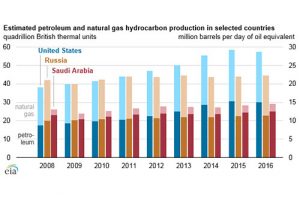US remains top natural gas producer for five years
The United States remained the world’s top producer of petroleum and natural gas hydrocarbons for the fifth straight year in 2016, despite production declines for both petroleum and natural gas relative to their 2015 levels, the Energy Information Administration (EIA) reports.
The U.S. has been the world’s top producer of natural gas since 2009 when the nation’s natural gas production surpassed that of Russia, according to EIA. It has been the world’s top producer of petroleum hydrocarbons since 2013 when the nation’s production exceeded that of Saudi Arabia.
For the U.S. and Russia, total petroleum and natural gas hydrocarbon production is almost evenly split between petroleum and natural gas, while Saudi Arabia’s production heavily favors petroleum, EIA says. Total petroleum production is made up of several types of liquid fuels, including crude oil and lease condensate, tight oil, extra-heavy oil and bitumen. Various processes produce natural gas plant liquids – like propane – as well as biofuels, refinery processing gain and other liquid fuels.
In the U.S., crude oil and lease condensate accounted for about 60 percent of total petroleum hydrocarbon production in 2016. However, U.S. petroleum production fell by 300,000 barrels per day (bpd) in 2016 as a result of relatively low oil prices, EIA reports.
With rapid growth in natural gas production through 2015 and a very mild 2015-16 winter heating season that reduced demand for natural gas as a heating fuel, average U.S. natural gas prices in 2016 were at their lowest level since 1999. Despite a modest recovery in prices later in the year, natural gas production decreased by 2.3 billion cu. ft. per day in 2016. In addition, U.S. petroleum and other liquid fuels production is expected to increase to 15.6 million bpd in 2017 and 16.7 million bpd in 2018, according to EIA’s Short-Term Energy Outlook in June.

















